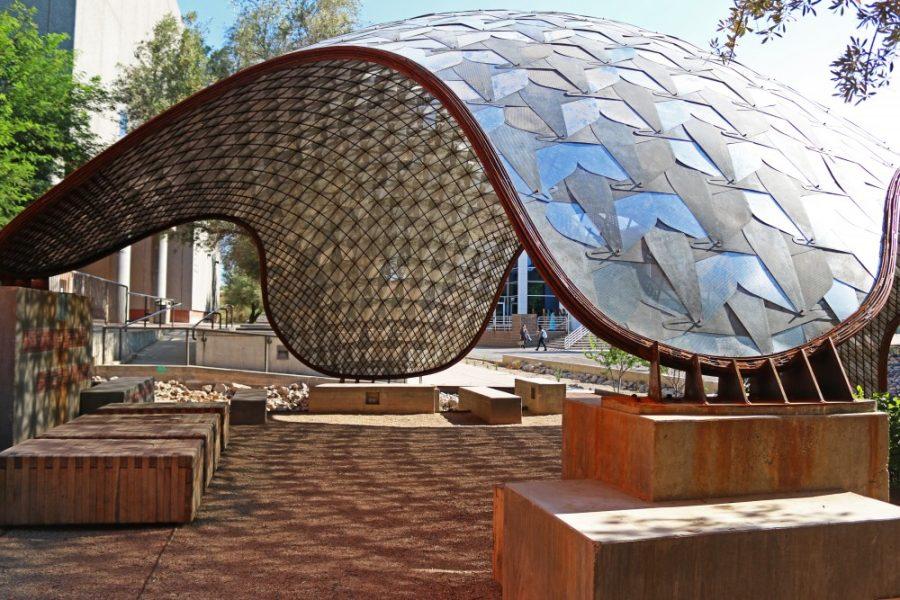To a student passing by and searching for shade on an unreasonably hot day, the recently completed Sonoran Pentapus may appear to be merely an eye-catching piece of art. Although it is that, there is more than creativity that was crucial in the construction of the Pentapus, which takes its name from the desert environment and the five points where it touches the earth.
The University of Arizona’s College of Architecture, Planning and Landscape Architecture recently took part in a multi-university experimental project with the goal being to learn, create and build “grid-shell typology” structures. The architecture students spent time studying and learning about the “grid-shell” and how best to build it long before they got into any hands-on activities.
Chris Trumble, an associate professor at CAPLA, explained that the project was different from some of the students’ previous work, which included assembling urban gardens, furniture installations and children’s playgrounds. The grid-shell structure project, however, a multi-university international grant about researching best practices in architecture, was one of the more difficult projects for the students.
RELATED: School of Architecture’s Sonoran Pentapus to be completed mid-December
The Pentapus construction involved “trying to make a wonderful space out of a horrible space,” Trumble said. The grounds where the Pentapus was built were the center of a busy area that held a large amount of concrete.
A previous architecture student Alex Mayer recalled that before the building of the Pentapus could begin a demolition to prepare the platform of the structure was needed. He said it required hands-on labor, which most of the students were not used to, but that it also proved a great learning experience for everyone.
The project also required a substantial amount of welding, which was estimated to take about three months. Instead, the students found themselves welding for more than a year and the project was delayed before finally being completed early May 2017.
Katie Roch, an architecture graduate, said, “five or six people on our team actually got their welding certification as an undergraduate.”
Roch said the welding was crucial to the structure and more complicated than most people might think. While other universities in the “grid-shell typology” project were utilizing wood, UA architecture students used steel. The primary reason was that wood does not withstand the harsh Sonoran weather for long, especially during the summer.
Despite the difference in materials used by each of the universities, Roch mentioned that the project allowed students from each university to learn from each other and observe tactics that work and don’t work for the grid-shell structure. Roch said other teams in North Carolina and Louisiana were at different stages of the process and completed their grid-shell structures earlier because they were not working with steel.
”[The team] worked hours and hours on end. We’d work on it over the summer and on weekends,” Roch said. The students spent time laser-scanning the structure multiple times, shooting nodes into the edifice in order to generate a digital model.
RELATED: Rooftop garden competitors give final proposals
The model was then sent to engineers in Toronto, who helped students understand where the Pentapus needed improvement by a process called “finite element analysis.”
Trumble and Mayer both said students made a wonderful partnership with the University of Arizona Facilities Management and Risk Management departments, which spent a considerable amount of time teaching the students how to go about the project.
Although it remains a stunning piece of artwork, the Pentapus also symbolizes the improvement, learning and challenges of students who put their effort and passion into the structure.
Trumble said that the zinc-plated steel structure contains holes that cast shadows during the day. He recalls that during the recent eclipse, the structure’s tiny openings served as “pinhole cameras” that scattered beautiful crescent moons upon the ground. The Pentapus may prove to be a spectacular landmark on campus and a stunning addition to the university-level architectural world.
Follow The Daily Wildcat on Twitter.

















